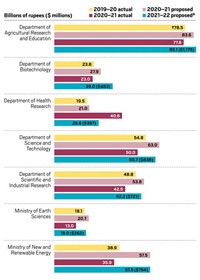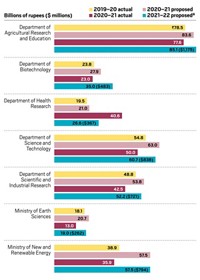Advertisement
Grab your lab coat. Let's get started
Welcome!
Welcome!
Create an account below to get 6 C&EN articles per month, receive newsletters and more - all free.
It seems this is your first time logging in online. Please enter the following information to continue.
As an ACS member you automatically get access to this site. All we need is few more details to create your reading experience.
Not you? Sign in with a different account.
Not you? Sign in with a different account.
ERROR 1
ERROR 1
ERROR 2
ERROR 2
ERROR 2
ERROR 2
ERROR 2
Password and Confirm password must match.
If you have an ACS member number, please enter it here so we can link this account to your membership. (optional)
ERROR 2
ACS values your privacy. By submitting your information, you are gaining access to C&EN and subscribing to our weekly newsletter. We use the information you provide to make your reading experience better, and we will never sell your data to third party members.
Policy
China Reveals R&D Spending
Investment: Researchers use financial disclosures to give first glimpse of government’s science spending
by Andrea Widener
September 1, 2014
| A version of this story appeared in
Volume 92, Issue 35
In the past decade, China has grown into an international research powerhouse. It recently passed the European Union in the percentage of gross domestic product it spends on R&D. Now, an analysis details for the first time how China is spending its science and technology (S&T) funds.
Among the revelations in a report published last week is that the role of China’s most powerful research agency is on the decline. And although the country overall is spending much more on research, China’s spending on basic and applied science is decreasing (Science 2014, DOI: 10.1126/science.1253479).
“This is important stuff,” says Denis Simon, an expert on China’s S&T at Arizona State University. “The Chinese have not made very transparent the structure and operation of how [S&T] was budgeted.”
China R&D By The Numbers
A new study in Science gives the first glimpse into China’s science and technology (S&T) budget. A few highlights follow.
Government and private Chinese R&D spending in 2011:
Basic research: 4.74%
Applied research: 11.84%
Development research: 83.42%
Total = $141.6 billiona
S&T budget in 2011, Ministry of Science & Technology (MOST):
$4.5 billiona
S&T budget in 2011, Chinese Academy of Sciences:
$3.1 billiona
Government contribution to total R&D spending in 2011:
21.7%
Compared to the contribution from private enterprise:
77.9%
China’s total R&D spending as a percentage of gross domestic product in 1996 was 0.57% which more than tripled by 2012 to 1.98% surpassing the European Union’s 1.96% but still lagging behind the U.S. value of 2.79%.
a Converted by C&EN to U.S. dollars at the Aug. 8 exchange rate of 1 yuan (RMB) = $0.163 U.S.
SOURCES: Science, World Bank
The review by innovation policy experts Yutao Sun and Cong Cao of the University of Nottingham, in England, was possible because of new open-government policies that require Chinese agencies to report their budgets. “Since the government is spending an increasing amount of money, how that money is spent is an important issue,” Cao explains.
Cao and Sun gathered budgets for 2011 from 71 agencies. The information does not include still-secret Chinese military R&D spending, which could account for just under half of research spending, Cao says.
One of the biggest surprises in these numbers was the diminishing role of the Ministry of Science & Technology (MOST) in relation to other agencies, Simon says. MOST once managed the country’s civilian R&D spending, but this analysis makes it clear that more money is being redirected by the central government.
MOST’s budget is 27.67 billion yuan (RMB), about $4.5 billion. Among its top competitors are the Chinese Academy of Sciences, which runs research labs with a budget of $3.1 billion (18.95 billion RMB), and the National Natural Science Foundation of China, which gives peer-reviewed grants, with a $2.4 billion (14.66 billion RMB) budget. Together, those three agencies account for 70% of China’s S&T spending.
MOST’s decline leads to questions about who is guiding the central Chinese government’s research policy, Simon says. “There is almost too much money in the system now,” which can lead to waste and abuse, he says. “What is the process by which the decisions are being made about who to give that money to?”
The Chinese government is contributing a surprisingly small amount of the country’s total civilian R&D funding of $141.6 billion (868.7 billion RMB), Cao says, given that the country’s leaders say they want to foster more innovation. Just 21.7% comes from government, whereas 77.9% is from private enterprises; nonprofits are thought to provide the remaining 0.4%. This explains the relatively large amount of money funneled toward development, to the neglect of basic and applied research. “Total basic research is less than 5%,” Cao says. Much of the growth in spending has come from enterprises, but that doesn’t help if more innovation is a goal, he adds.
To improve overall innovation in China, Cao and Sun recommend that the government boost its spending to 30% of the country’s total R&D funding and direct more money to basic and applied research. They also suggest the government create an organization to coordinate research policy and a health-focused research agency equivalent to the U.S.’s National Institutes of Health.





Join the conversation
Contact the reporter
Submit a Letter to the Editor for publication
Engage with us on Twitter